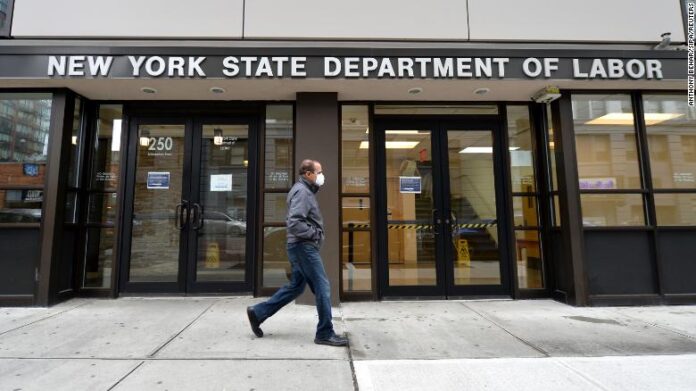WASHINGTON: A staggering 16.8 million Americans have filed for unemployment benefits in the last three weeks, with weekly new claims topping 6 million for the second straight time last week as the novel coronavirus outbreak relentlessly savages the economy.
Thursday’s weekly jobless claims report from the Labor Department, the most timely data on the economy’s health, strengthens economists’ expectations of job losses of up to 20 million in April and their conviction that the economy is in deep recession. It also underscored an urgent need for more fiscal stimulus to halt the free fall, economists said.
“In its first month alone, the coronavirus crisis is poised to exceed any comparison to the Great Recession,” said Daniel Zhao, senior economist at Glassdoor, a website recruitment firm. “The new normal for unemployment insurance claims will be the canary in the coal mine for how long effects of the crisis will linger for the millions of newly unemployed Americans.”
The record unemployment insurance claims numbers are the result of businesses such as restaurants, bars and other social venues being shuttered as states and local governments implement tough measures to control the spread of COVID-19, the respiratory illness caused by the coronavirus.
Initial claims for state unemployment benefits slipped 261,000 to a seasonally adjusted 6.606 million for the week ended April 4, the government said. Data for the prior week was revised to show 219,000 more applications received than previously reported, taking the tally for that period to 6.867 million. All told, a record 16.78 million people have filed claims for jobless benefits since the week ending March 21.
Economists polled by Reuters had forecast claims slipping to 5.250 million in the latest week, though estimates in the survey were as high as 9.295 million.
“Today’s report continues to reflect the purposeful sacrifice being made by America’s workers and their families to slow the spread of the coronavirus,” said Labor Secretary Eugene Scalia in a statement.
Last week’s moderation in claims is probably temporary as more than 95 per cent of Americans are now under “stay-at-home” or “shelter-in-place” orders. Reports are mounting of state employment offices being overwhelmed by a flood of applications.
The breadth of businesses shuttered has widened to include transportation and factories. Retailers have also furloughed workers. Labor market turmoil led to consumer sentiment tumbling a record 18.1 points in early April to 71.0, the lowest reading since December 2011, a separate report showed on Thursday.
The Federal Reserve on Thursday rolled out a broad, $2.3 trillion effort to bolster local governments and small and mid-sized businesses in its latest move to keep the economy intact. Fed Chair Jerome Powell said the US central bank would continue to use all the tools at its disposal until the economy started to fully rebound.
President Donald Trump last month signed a historic $2.3 trillion rescue package, which made provisions for companies and the unemployed. Both Trump and US House of Representatives Speaker Nancy Pelosi have floated an infrastructure stimulus.
Stocks on Wall Street rallied on the latest stimulus from the Fed, while the dollar declined against a basket of currencies. US Treasury prices were trading higher.
MILLIONS UNEMPLOYED
The government reported last Friday that the economy purged 701,000 jobs in March. That was the most job losses since the Great Recession and ended the longest employment boom in US history that started in late 2010.
Economists say there is an urgent need for additional fiscal stimulus to help the economy. With the recent package enhancing unemployment benefits, the are concerns that businesses are encouraging their lowest paid hourly workers to take advantage of an extra $600 per week for up to four months.
This is on top of existing jobless benefits, which averaged $385 per person per month in January. It is equivalent to $15 per hour for a 40-hour workweek. The government-mandated minimum wage is about $7.25 per hour.
“This may in turn be part of the reason why jobless claims have soared so rapidly in recent weeks,” said Andrew Hunter, a senior US economist at Capital Economics. “Workers may be more accepting of temporary furloughs if they stand to lose little income, and several major retailers have cited the new provisions when announcing layoffs.”
Thursday’s claims report also showed the number of people continuing to receive benefits after an initial week of aid shot up 4.396 million to a record 7.455 million in the week ending March 28, obliterating the previous all-time high of 6.635 million set in May 2009.
The so-called continuing claims data is reported with a one-week lag and is viewed as a better gauge of unemployment and its impact on gross domestic product.
The unemployment rate rose 0.9 percentage point, the largest single-month change since January 1975, to 4.4pc in March. The government said the rate could have been 5.4pc if it were not for a misclassification error during the survey of households.
The economy is believed to have contracted sharply in the first quarter, with even an historic decline in GDP being forecast for the second quarter. Economists say the economy entered recession in March.
The National Bureau of Economic Research, the private research institute regarded as the arbiter of U.S. recessions, does not define a recession as two consecutive quarters of decline in real gross domestic product, as is the rule of thumb in many countries. Instead, it looks for a drop in activity, spread across the economy and lasting more than a few months.




